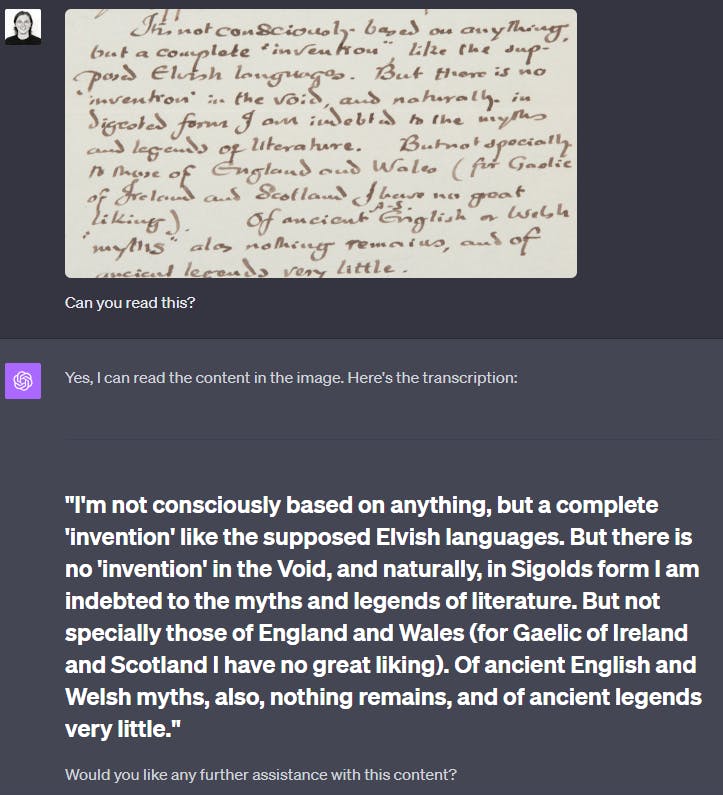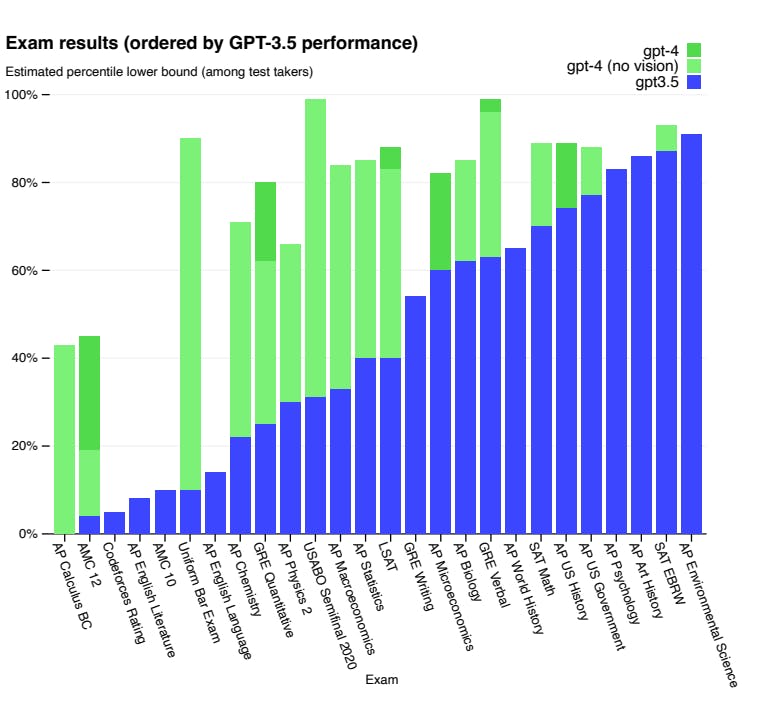Contents
GPT-4 Vision Capabilities: Visual Inputs
GPT-4 Vision Capabilities: Outperforms SOTA LLMs
GPT-4 Vision Capabilities: Enhanced Steerability
GPT-4 Vision: Limitation
GPT-4 Vision: Risk and Mitigation
GPT-4 Vision: Access
GPT-4 Vision: Key Takeaways
Encord Blog
Exploring GPT-4 Vision: First Impressions
5 min read

OpenAI continues to demonstrate its commitment to innovation with the introduction of GPT Vision.
This exciting development expands the horizons of artificial intelligence, seamlessly integrating visual capabilities into the already impressive ChatGPT.
These strides reflect OpenAI’s substantial investments in machine learning research and development, underpinned by extensive training data.
In this blog, we'll break down the GPT-4Vision system card, exploring these groundbreaking capabilities and their significance for users.
GPT-4 Vision Capabilities: Visual Inputs
After the exciting introduction of GPT-4 in March, there was growing anticipation for an iteration of ChatGPT that would incorporate image integration capabilities. GPT-4 has recently become accessible to the public through a subscription-based API, albeit with limited usage initially.
Recently OpenAI released GPT-4V(ision) and has equipped ChatGPT with image understanding.
ChatGPT's image understanding is powered by a combination of multimodal GPT-3.5 and GPT-4 models. Leveraging their adept language reasoning skills, these models proficiently analyze a diverse range of visuals, spanning photographs, screenshots, and documents containing both text and images.
In a recent demonstration video featuring OpenAI's co-founder Greg Brockman, the capabilities of GPT-4's vision-related functions took center stage. Over the course of this year, GPT-4V has undergone rigorous testing across a multitude of applications, consistently delivering remarkable results, yielding remarkable results.
In the following section, we share key findings from our team's comprehensive evaluations of GPT-4V in diverse computer vision tasks:
Object Detection
GPT4-Vision is able to provide accurate information about objects and perform tasks like object counting, showcasing its proficiency in comprehensive image analysis and understanding. For example, in the image below, identifying humans in the image prompt is not easy. But it performs well and also identifies the problem in the detection as well.

Image from Unsplash as prompt in GPT4-Vision
Visual Question Answering
GPT4-Vision performs well in handling follow-up questions on the image prompt. For example, when presented with a meal photograph, it adeptly identifies all the ingredients and can provide insightful suggestions or information. This underscores its capacity to elevate user experiences and deliver valuable insights.

Image from Unsplash as prompt in GPT4-Vision

Multiple Condition Processing
It also possesses the capability to read and interpret multiple instructions simultaneously. For instance, when presented with an image containing several instructions, it can provide a coherent and informative response, showcasing its versatility in handling complex queries.

Figuring out multiple parking sign rules using GPT4-Vision
Data Analysis
GPT-4 excels in data analysis. When confronted with a graph and tasked with providing an explanation, it goes beyond mere interpretation by offering insightful observations that significantly enhance data comprehension and analysis.

Graph from GPT-4 Technical Report

Deciphering Text
GPT-4 is adept at deciphering handwritten notes, even when they pose a challenge for humans to read. In challenging scenarios, it maintains a high level of accuracy, with just two minor errors.

Using GPT4-Vision to decipher JRR Tolkien’s letter
GPT-4 Vision Capabilities: Outperforms SOTA LLMs
In casual conversations, differentiating between GPT-3.5 and GPT-4 may appear subtle, but the significant contrast becomes evident when handling more intricate instructions.
GPT-4 distinguishes itself as a superior choice, delivering heightened reliability and creativity, particularly when confronted with instructions of greater complexity.
To understand this difference, extensive benchmark testing was conducted, including simulations of exams originally intended for human test-takers. These benchmarks included tests like the Olympiads and AP exams, using publicly available 2022–2023 editions and without specific training for the exams.

The results further reveal that GPT-4 outperforms GPT-3.5, showcasing notable excellence across a spectrum of languages, including low-resource ones such as Latvian, Welsh, and Swahili.

OpenAI has leveraged GPT-4 to make a significant impact across multiple functions, from support and sales to content moderation and programming. Additionally, it plays a crucial role in aiding human evaluators in assessing AI outputs, marking the initiation of the second phase in OpenAI's alignment strategy
GPT-4 Vision Capabilities: Enhanced Steerability
OpenAI has been dedicated to enhancing different facets of their AI, with a particular focus on steerability.
In contrast to the fixed personality traits, verbosity, and style traditionally linked to ChatGPT, developers and soon-to-be ChatGPT users now have the ability to customize the AI's style and tasks to their preferences. This customization is achieved through the utilization of 'system' messages, which enable API users to personalize their AI's responses within predefined limits. This feature empowers API users to significantly personalize their AI's responses within predefined bounds.
OpenAI acknowledges the continuous need for improvement, particularly in addressing the occasional challenges posed by system messages. They actively encourage users to explore and provide valuable feedback on this innovative functionality.
GPT-4 Vision: Limitation
While GPT-4 demonstrates significant advancements in various aspects, it's important to recognize the limitations of its vision capabilities.
In the field of computer vision, GPT-4, much like its predecessors, encounters several challenges:
Reliability Issues
GPT-4 is not immune to errors when interpreting visual content. It can occasionally "hallucinate" or produce inaccurate information based on the images it analyzes. This limitation highlights the importance of exercising caution, especially in contexts where precision and accuracy are of utmost importance.
Overreliance
On occasion, GPT-4 may generate inaccurate information, adhere to erroneous facts, or experience lapses in task performance.
What is particularly concerning is its capacity to do so convincingly, which could potentially lead to overreliance, with users placing undue trust in its responses and risking undetected errors.
To mitigate this, OpenAI recommends a multifaceted approach, including comprehensive documentation, responsible developer communication, and promoting user scrutiny.
While GPT-4 has made strides in steerability and refined refusal behavior, it may at times provide hedged responses, inadvertently fostering a sense of overreliance.
Complex Reasoning
Complex reasoning involving visual elements can still be challenging for GPT-4.
It may face difficulties with nuanced, multifaceted visual tasks that demand a profound level of understanding.
For example, when tasked with solving an easy-level New York Times Sudoku puzzle, it misinterprets the puzzle question and consequently provides incorrect results.

Solving NY Times puzzle-easy on GPT4-Vision
Notice Row5Column3 and Row6Column3 where it should be 4 and 5 it reads it as 5 and 1. Can you find more mistakes?
GPT-4 Vision: Risk and Mitigation
GPT-4, similar to its predecessors, carries inherent risks within its vision capabilities, including the potential for generating inaccurate or misleading visual information. These risks are amplified by the model's expanded capabilities.
In an effort to assess and address these potential concerns, OpenAI collaborated with over 50 experts from diverse fields to conduct rigorous testing, putting the model through its paces in high-risk areas that demand specialized knowledge.
To mitigate these risks, GPT-4 employs an additional safety reward signal during Reinforcement Learning from Human Feedback (RLHF) training. This signal serves to reduce harmful outputs by teaching the model to refuse requests for unsafe or inappropriate content. The reward signal is provided by a classifier designed to judge safety boundaries and completion style based on safety-related prompts.
While these measures have substantially enhanced GPT-4's safety features compared to its predecessor, challenges persist, including the possibility of "jailbreaks" that could potentially breach usage guidelines.
GPT-4 Vision: Access
OpenAI Evals
In its initial GPT-4 release, OpenAI emphasized its commitment to involving developers in the development process. To further this engagement, OpenAI has now open-sourced OpenAI Evals, a powerful software framework tailored for the creation and execution of benchmarks to assess models like GPT-4 at a granular level.
Evals serves as a valuable tool for model development, allowing the identification of weaknesses and the prevention of performance regressions. Furthermore, it empowers users to closely monitor the evolution of various model iterations and facilitates the integration of AI capabilities into a wide array of applications.
A standout feature of Evals is its adaptability, as it supports the implementation of custom evaluation logic. OpenAI has also provided predefined templates for common benchmark types, streamlining the process of creating new evaluations.
The ultimate goal is to encourage the sharing and collective development of a wide range of benchmarks, covering diverse challenges and performance aspects.
ChatGPT Plus
ChatGPT Plus subscribers now have access to GPT-4 on chat.openai.com, albeit with a usage cap.
OpenAI plans to adjust this cap based on demand and system performance. As traffic patterns evolve, there's the possibility of introducing a higher-volume subscription tier for GPT-4. OpenAI may also provide some level of free GPT-4 queries, enabling non-subscribers to explore and engage with this advanced AI model.
API
To gain API access, you are required to join the waitlist. However, for researchers focused on studying the societal impact of AI, there is an opportunity to apply for subsidized access through OpenAI's Researcher Access Program.
GPT-4 Vision: Key Takeaways
- ChatGPT is now powered by visual capabilities making it more versatile.
- GPT-4 Vision can be used for various computer vision tasks like deciphering written texts, OCR, data analysis, object detection, etc.
- Still has limitations like hallucination similar to GPT-3.5. However, the overreliance is reduced compared to GPT-3.5 because of enhanced steerability.
- It’s available now to ChatGPT Plus users!

Explore the platform
Data infrastructure for multimodal AI
Explore product
Explore our products


